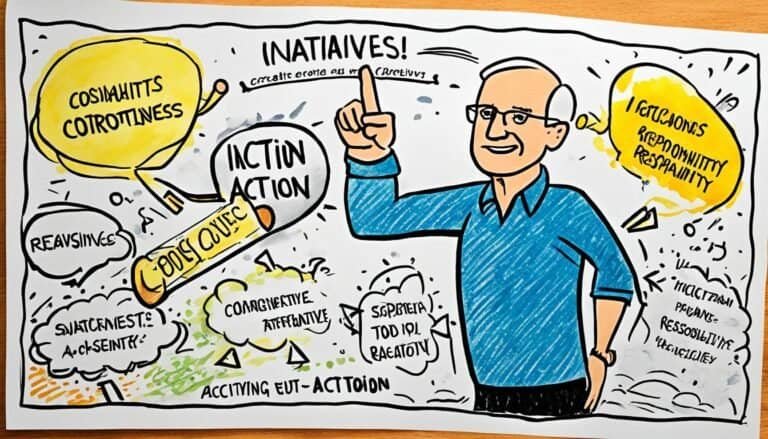Critical Thinking Insights: Lessons from Edward de Bono
“The need to be right all the time is the biggest bar to new ideas. It is better to have enough ideas for some of them to be wrong than to be always right by having no ideas at all.” – Edward de Bono
Edward de Bono, a renowned thinker and creator of the Lateral Thinking concept, dedicated his life to inspiring individuals and teams to become better and more creative thinkers. His innovative methods, such as The Six Thinking Hats®, provide a structured approach for developing new ideas and problem-solving. By breaking old thinking patterns and embracing new perspectives, individuals can unleash their creative potential and enhance their critical thinking skills.
Key Takeaways:
- Learn valuable lessons from Edward de Bono’s techniques and thinking tools.
- Discover the power of lateral thinking strategies and creativity methods.
- Explore problem-solving techniques that can transform your approach.
- Develop critical thinking skills through innovative strategies.
- Unlock your creative potential and drive innovation in all aspects of your life.
Who is Edward de Bono?
Dr. Edward de Bono is a renowned thinker and author who introduced the concept of Lateral Thinking and has written extensively on the importance of thinking as a skill. His innovative methods have empowered individuals and teams to cultivate creativity, problem-solving, and effective decision-making abilities.
Edward de Bono’s contributions to the field of thinking methods have made him a prominent figure in the world of cognitive development. With his expertise, he has developed strategies and techniques that encourage individuals to be more receptive to new ideas and approach problem-solving from diverse perspectives.
Through his books, such as “Lateral Thinking: Creativity Step by Step” and “Six Thinking Hats,” Dr. de Bono has made his methods accessible to a wide audience. These resources serve as comprehensive guides for anyone seeking to enhance their thinking abilities, whether in personal or professional contexts.
In addition to books, Edward de Bono has also collaborated with training partners to offer workshops and seminars focused on his methods. These interactive sessions provide practical learning experiences that enable individuals to apply de Bono’s techniques in real-world scenarios.
Recognizing the importance of nurturing thinking skills from an early age, Edward de Bono has also developed thinking lessons specifically tailored for schools and families. These educational materials offer a structured approach to fostering creativity, problem-solving, and critical thinking abilities among students of all ages.
Edward de Bono’s methods have proven to be powerful tools for those seeking to expand their thinking horizons and unlock their creative potential. Whether through his books, training programs, or educational materials, anyone can benefit from his expertise and enrich their thinking capabilities.
Learning from Edward de Bono
Edward de Bono’s methods provide a roadmap for individuals to develop their thinking skills and embrace a more creative and inclusive approach to problem-solving. By adopting his techniques, individuals can break free from rigid thinking patterns and discover new possibilities that may have remained hidden otherwise. Let’s dive into some of the key concepts and strategies proposed by Edward de Bono in the upcoming sections of this article, exploring how they can revolutionize our thinking and enhance problem-solving abilities.
Lateral Thinking: A Structured Approach
Lateral Thinking, developed by Edward de Bono, offers a structured approach for thinking differently and fostering alternative thinking. It recognizes that the mind functions as a self-organizing pattern recognition system and aims to break away from locked-in views and patterns. By doing so, individuals can open themselves to new possibilities and generate creative alternatives.
This approach to thinking challenges conventional wisdom by encouraging individuals to explore beyond the obvious and consider unconventional solutions. Lateral Thinking provides a framework that helps organize thoughts, leading to the creation of innovative ideas and problem-solving strategies.
At its core, Lateral Thinking encourages individuals to reframe problems, look at them from different angles, and generate alternatives. It prompts individuals to question assumptions and uncover fresh perspectives that may have been previously overlooked. By adopting Edward de Bono’s approach, individuals can enhance their ability to think outside the box and find unique solutions to complex challenges.
Lateral Thinking in Action
Let’s explore how Lateral Thinking works in practice. Imagine a team tasked with developing a new advertising campaign for a product targeted at young adults. Using Lateral Thinking, the team members would come together to brainstorm ideas and perspectives that deviate from the usual strategies. They might experiment with unusual marketing channels, creative storytelling approaches, or even unconventional collaborations.
| Traditional Thinking | Lateral Thinking |
|---|---|
| Focuses on standard advertising methods | Explores alternative platforms and channels |
| Relies on known and proven strategies | Challenges assumptions and breaks away from conventions |
| Sticks to the comfort zone | Embraces innovation and takes risks |
As seen in the table above, Lateral Thinking encourages individuals to shift away from traditional thinking patterns and create alternatives. By considering different perspectives and exploring unconventional ideas, the team can develop a unique and effective advertising campaign that stands out in a crowded market.
The Six Thinking Hats: Exploring and Implementing Ideas
Edward de Bono’s Six Thinking Hats is a powerful method that facilitates the exploration and implementation of ideas through a structured approach. By using different thinking styles represented by six colored hats, individuals and groups can effectively separate and analyze various perspectives, enabling constructive thinking and collaboration.
The Six Thinking Hats is a natural extension of the Lateral Thinking concept developed by Edward de Bono. While Lateral Thinking focuses on generating new ideas, the Six Thinking Hats builds upon this foundation to further develop and implement those ideas.
This method encourages individuals to wear different hats, each representing a specific thinking style or approach. The different hats symbolize different modes of thinking, allowing for a comprehensive examination of ideas from various angles. Here are the six hats and their associated thinking styles:
| Hat | Color | Thinking Style |
|---|---|---|
| White Hat | White | Objective Thinking: Focus on facts, information, and data. |
| Red Hat | Red | Emotional Thinking: Express feelings, hunches, and intuition. |
| Black Hat | Black | Critical Thinking: Identify risks, problems, and potential downsides. |
| Yellow Hat | Yellow | Positive Thinking: Explore benefits, optimism, and potential advantages. |
| Green Hat | Green | Creative Thinking: Generate new ideas, possibilities, and alternatives. |
| Blue Hat | Blue | Organizational Thinking: Facilitate and manage the thinking process. |
By systematically wearing each hat and adopting its respective thinking style, individuals can thoroughly explore and analyze ideas, ensuring a balanced consideration of multiple perspectives. This approach promotes constructive thinking and effective decision-making, as it eliminates biases and encourages open-mindedness.
Implementing the Six Thinking Hats technique in brainstorming sessions, meetings, or problem-solving sessions can lead to more productive discussions and efficient idea development. By assigning roles to different individuals or groups, everyone can contribute unique insights while ensuring a comprehensive exploration of ideas.
It is important to note that the goal of the Six Thinking Hats is not to reach a consensus or agreement immediately. Instead, it focuses on stimulating constructive thinking and facilitating a thorough examination of ideas before making a decision or taking action.
Edward de Bono’s Six Thinking Hats offers a structured framework for exploring ideas and ensuring their effective implementation. By leveraging this method, individuals and teams can navigate complex challenges, encourage collaboration, and generate innovative solutions.
Benefits of Edward de Bono’s Methods
Edward de Bono’s methods offer several benefits. By utilizing these powerful techniques, individuals and teams can tap into their creativity and problem-solving abilities, ultimately leading to innovative solutions and improved collaboration.
Enhanced Creativity
The Edward de Bono methods provide a framework for unlocking and expanding creativity. Through lateral thinking and alternative approaches, individuals can break free from traditional thought patterns and generate fresh ideas. By encouraging individuals to change their perspective and consider multiple answers, these methods foster a creative mindset.
Improved Problem-Solving
One of the key benefits of Edward de Bono’s methods is their effectiveness in solving complex problems. The structured approach of lateral thinking enables individuals to explore different angles and generate unique solutions. By thinking outside the box and challenging conventional approaches, individuals can overcome obstacles and find innovative ways to address challenges.
Effective Collaboration
Edward de Bono’s methods also promote effective collaboration within teams. By adopting these techniques, team members can align their thinking towards a common goal, facilitating open communication and a shared understanding. The Six Thinking Hats, one of de Bono’s popular methods, helps manage conflict resolution by encouraging constructive and unbiased discussions.
Edward de Bono methods provide individuals and teams with the tools to create new solutions, recognize neglected opportunities, and improve collaboration and conflict resolution.
Moreover, these methods enhance critical thinking skills by challenging traditional approaches and encouraging individuals to think independently. Breaking away from old patterns allows for a more comprehensive analysis of problems and the development of innovative strategies.
Embracing Edward de Bono’s methods not only benefits individuals but also creates a culture of creativity, problem-solving, and collaboration within organizations. By incorporating these techniques into daily practices, businesses and teams can thrive in navigating complex challenges and driving innovation.
Edward de Bono methods foster a culture that embraces creativity, problem-solving, and collaboration, leading to innovative solutions and improved team dynamics.
Case Studies: Real-Life Applications of de Bono Methods
Edward de Bono’s methods have been proven effective through real-life case studies in various industries. These practical examples highlight the power and versatility of de Bono’s techniques in fostering creative problem-solving and driving innovation.
“Lateral Thinking enabled me to eliminate nine unnecessary steps in the Kevlar manufacturing process, resulting in annual savings of $30 million for DuPont.”
One notable case study comes from DuPont, where an employee applied Lateral Thinking to streamline the Kevlar manufacturing process. By breaking away from traditional thinking patterns, they were able to identify and eliminate unnecessary steps, saving the company a staggering $30 million annually. This success story showcases the transformative impact of de Bono’s methods on cost reduction and process optimization.
Another case study involves an advertising agency that used de Bono’s techniques to solve a complex client brief. By applying creative problem-solving strategies, they were able to develop an innovative advertising campaign that exceeded client expectations and garnered significant public attention. This example demonstrates how de Bono’s methods can generate breakthrough ideas and deliver exceptional results in real-world scenarios.
Additionally, in the technology industry, a software development team implemented de Bono’s methods to overcome a challenging technical problem. Through collaborative thinking and the use of alternative approaches, they successfully resolved the issue, resulting in a more efficient and user-friendly software application. This case study illustrates the applicability and effectiveness of de Bono’s methods in driving problem-solving and enhancing product development processes.
These case studies validate the practicality and real-life impact of de Bono’s methods in a wide range of industries and problem-solving contexts. From cost savings and process optimization to breakthrough innovations, the evidence is clear: adopting de Bono’s techniques can yield significant outcomes and drive success.
By understanding and implementing Edward de Bono’s methods, individuals and teams can unlock their creative potential and tackle complex challenges with confidence. The following section will further explore the need for Lateral Thinking and debunk common myths surrounding creative problem-solving.
The Need for Lateral Thinking: Shattering Myths
Lateral Thinking is a powerful approach that challenges the belief that traditional thinking methods alone are sufficient for solving complex problems and generating creative solutions. Developed by Edward de Bono, this innovative technique aims to break free from conventional thinking patterns and shatter myths around creative thinking.
Many people mistakenly assume that problem-solving and creativity can be achieved by following linear thought processes. However, Lateral Thinking offers a paradigm shift by emphasizing the importance of thinking differently and exploring alternatives.
Redefining Focus and Challenging Thinking Patterns
In order to unlock new perspectives and generate fresh ideas, it is essential to redefine our focus and challenge our thinking patterns. Lateral Thinking encourages individuals to step outside their comfort zones and consider unconventional approaches to problem-solving. By consciously breaking away from preconceived notions, we open ourselves up to new possibilities and creative solutions.
Breeding New Ideas with Alternatives
Lateral Thinking recognizes the value of alternatives and their role in breeding new ideas. Often, the best solutions lie outside the realm of traditional thinking. By exploring alternative paths and considering unconventional perspectives, we can uncover innovative approaches that lead to breakthrough solutions.
“Lateral thinking is closely related to creativity. It involves changing the pattern and searching for alternatives that may have otherwise been missed.” – Edward de Bono
Edward de Bono’s powerful concept of Lateral Thinking challenges us to question established thinking patterns and embrace a more creative and inclusive approach to problem-solving. By daring to think differently and shattering the myths surrounding creative thinking, we open up a world of possibilities and unlock our true potential.
To further illustrate the value of Lateral Thinking, let’s explore a case study that exemplifies its impact:
| Case Study: Redefining the Automotive Industry |
|---|
|
In the late 1990s, the traditional automotive industry was facing a multitude of challenges, including environmental concerns and rising fuel prices. By embracing Lateral Thinking, visionary companies like Tesla disrupted the industry by introducing electric vehicles and innovative energy solutions. This departure from conventional thinking not only revolutionized the automotive market but also contributed to a more sustainable future. |
Outcomes and Benefits of Learning Lateral Thinking
Learning Lateral Thinking provides individuals with a multitude of valuable outcomes and benefits. By embracing this approach to problem-solving, decision making, and innovation, individuals can transform their thinking processes and unlock their creative potential.
Shattering Myths Around Creative Thinking
One of the key outcomes of learning Lateral Thinking is the ability to shatter myths around creative thinking. Often, individuals believe that creativity is an innate talent reserved for a select few. However, through the practice of Lateral Thinking, individuals can discover that creativity is a skill that can be learned and honed. This realization empowers individuals to unleash their creative thinking abilities and encourages a mindset of continuous growth and exploration.
Focus on Problem-Solving
Another significant outcome of learning Lateral Thinking is the sharpening of problem-solving skills. Lateral Thinking equips individuals with the tools and techniques to approach problem-solving from different angles, challenging conventional wisdom and unlocking innovative solutions. By breaking away from traditional linear thinking, individuals can explore new possibilities, generate fresh insights, and identify creative solutions to complex problems.
Developing a Creative Hit List
Lateral Thinking teaches individuals the importance of developing a “creative hit list.” This involves consciously seeking out diverse sources of inspiration and exposing oneself to different ideas, perspectives, and industries. By curating a creative hit list, individuals can expand their knowledge base, stimulate their imagination, and foster the generation of unique and groundbreaking ideas.
Extracting Concepts and Generating New Ideas
Learning Lateral Thinking enables individuals to extract valuable concepts from varied fields and creatively apply them to their own challenges. By recognizing patterns, making connections, and leveraging insights from unrelated domains, individuals can generate fresh ideas and innovative solutions. This ability to extract concepts and apply them in new contexts is a powerful tool for driving creativity, problem-solving, and innovation.
Using Random Input for New Connections
An intriguing outcome of learning Lateral Thinking is the ability to use random input as a catalyst for new connections. By incorporating seemingly unrelated elements into the thinking process, individuals can trigger unexpected associations and unlock novel insights. This practice of embracing randomness in thinking liberates the mind, fostering more expansive and creative thought patterns.
Turning Provocative Ideas into Practical Solutions
Lateral Thinking empowers individuals to explore provocative ideas and transform them into practical solutions. By challenging assumptions, pushing boundaries, and embracing unconventional thinking, individuals can break free from the constraints of traditional approaches and arrive at innovative and effective solutions. This outcome of Lateral Thinking enriches problem-solving skills and encourages a fearless and open-minded mindset.
Furthermore, learning Lateral Thinking enables individuals to challenge the current thinking within their organizations constructively. By leveraging the power of Lateral Thinking, individuals can question existing paradigms, stimulate creativity, and maximize the capture of ideas from creative thinking sessions.
Overall, the outcomes and benefits of learning Lateral Thinking are far-reaching. By embracing this approach, individuals can shatter myths around creative thinking, sharpen problem-solving skills, develop a creative hit list, extract concepts to generate new ideas, use random input for new connections, and turn provocative ideas into practical solutions. Lateral Thinking empowers individuals to think outside the box, fostering innovation, breakthrough thinking, and the ability to tackle complex challenges with agility and creativity.
Conclusion
Edward de Bono’s methods offer valuable lessons in critical thinking, enhancing creativity, problem-solving, and innovation. By adopting his techniques and tools, individuals and teams can develop their thinking skills, break away from old patterns, and create new and effective solutions.
Embracing the insights from Edward de Bono can lead to transformative thinking and enhanced problem-solving abilities. Through the application of lateral thinking, individuals can challenge conventional wisdom, consider multiple perspectives, and find unique solutions to complex problems.
By incorporating de Bono’s Six Thinking Hats method, teams can foster collaboration, constructive discussions, and effective decision-making. This approach enables individuals to explore and implement ideas systematically, leading to innovative solutions and improved outcomes.








